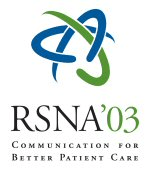Abstract:
HTML
Purpose: Focal anatomically selective BBB opening may prove useful for the targeted delivery of agents to the brain. Here, we tested the hypothesis that burst ultrasound in the presence of micro bubbles can open the Blood-Brain-Barrier (BBB) completely noninvasively at a frequency that can be focused through an intact skull.
Methods and Materials: The brains of 17 rabbits were sonicated in 4-6 locations ( frequency: 690 kHz, burst length: 10 microsec., repetition frequency: 1 Hz, 20 bursts, temporal peak acoustic power: up to 8 W, peak acoustic pressure amplitude: up to 3.1 MPa). Before each sonication, a bolus of ultrasound contrast agent (Optison) was injected intravenously. Contrast enhanced MR images were obtained after the sonications to detect BBB disruption at the targeted locations. The animals were sacrificed four hours after sonication. Whole brain histologic evaluation was performed; The sections were stained with H&E, TUNEL, and vanadium acid fuchsin to evaluate tissue effects including apoptosis and ischemia. To provide reliable exposure dosimetry the ultrasound beam was targeted in 53 locations through a craniotomy which was made at least 10 days before the experiments. BBB opening was confirmed in experiments in twelve location with sonications through the intact skull.
Results: At 0.43 MPa, focal BBB opening was observed at approximately 60% (3/5) of the sonicated locations. This percentage increased to 89% (8/9) at 0.53 MPa. At these pressure amplitudes, no histological damage to the neurons was observed. At 1.1 and 1.4 MPa, 100% of the locations had BBB opening. Neuronal damage was observed at 1/11 locations at these amplitudes. BBB opening was observed at all locations sonicated with higher pressure amplitudes. The histology findings indicated that brain tissue damage was induced at a pressure amplitude of 2.3 MPa (except the one location at 1 MPa). The damage included vascular wall damage, hemorrhage, and eventually necrosis. The apoptosis and ischemia study demonstrated a similar result. The trans-skull sonications also demonstrated focal opening of the BBB.
Conclusion: These experiments demonstrated BBB opening without neuronal damage at a frequency of 690 kHz, which can be focused through a human skull. The results extend a previous finding that BBB can be opened by using focused ultrasound at a frequency of 1.63 MHz that required a piece of skull bone to be removed. The This result is significant because it demonstrate the clinical potential of a transcranial non-invasive targeted drug delivery method.
Hynynen PhD, K,
Image-guided Focal Opening of the Blood Brain Barrier by Low-Frequency Transkull Ultrasound Exposures. Radiological Society of North America 2003 Scientific Assembly and Annual Meeting, November 30 - December 5, 2003 ,Chicago IL.
http://archive.rsna.org/2003/3104874.html

